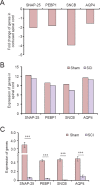Synaptosomal-associated protein 25 may be an intervention target for improving sensory and locomotor functions after spinal cord contusion
- PMID: 28761431
- PMCID: PMC5514873
- DOI: 10.4103/1673-5374.208592
Synaptosomal-associated protein 25 may be an intervention target for improving sensory and locomotor functions after spinal cord contusion
Abstract
Synaptosomal-associated protein 25 kDa (SNAP-25) is localized on the synapse and participates in exocytosis and neurotransmitter release. Decreased expression of SNAP-25 is associated with Alzheimer's disease and attention deficit/hyperactivity disorder. However, the expression of SNAP-25 in spinal cord contusion injury is still unclear. We hypothesized that SNAP-25 is associated with sensory and locomotor functions after spinal cord injury. We established rat models of spinal cord contusion injury to detect gene changes with a gene array. A decreased level of SNAP-25 was detected by quantitative real time-polymerase chain reaction and western blot assay at 1, 3, 7, 14 and 28 days post injury. SNAP-25 was localized in the cytoplasm of neurons of the anterior and posterior horns, which are involved in locomotor and sensory functions. Our data suggest that reduced levels of SNAP-25 are associated with sensory and locomotor functions in rats with spinal cord contusion injury.
Keywords: gene array; locomotor function; nerve regeneration; neural regeneration; neurons; sensory function; spinal cord injury; synaptosomal-associated protein 25 kDa.
Conflict of interest statement
Conflicts of interest: None declared.
Figures








Similar articles
-
Treatment of rat spinal cord injury with a Rho-kinase inhibitor and bone marrow stromal cell transplantation.Brain Res. 2009 Oct 27;1295:192-202. doi: 10.1016/j.brainres.2009.07.087. Epub 2009 Aug 3. Brain Res. 2009. PMID: 19651108
-
Low-energy extracorporeal shock wave therapy promotes vascular endothelial growth factor expression and improves locomotor recovery after spinal cord injury.J Neurosurg. 2014 Dec;121(6):1514-25. doi: 10.3171/2014.8.JNS132562. Epub 2014 Oct 3. J Neurosurg. 2014. PMID: 25280090
-
X-irradiation of the contusion site improves locomotor and histological outcomes in spinal cord-injured rats.Exp Neurol. 2001 Nov;172(1):228-34. doi: 10.1006/exnr.2001.7803. Exp Neurol. 2001. PMID: 11681855
-
The Lesioned Spinal Cord Is a "New" Spinal Cord: Evidence from Functional Changes after Spinal Injury in Lamprey.Front Neural Circuits. 2017 Nov 6;11:84. doi: 10.3389/fncir.2017.00084. eCollection 2017. Front Neural Circuits. 2017. PMID: 29163065 Free PMC article. Review.
-
Locomotor recovery after spinal cord hemisection/contusion injures in bonnet monkeys: footprint testing--a minireview.Synapse. 2013 Jul;67(7):427-53. doi: 10.1002/syn.21645. Epub 2013 Mar 19. Synapse. 2013. PMID: 23401170 Review.
Cited by
-
Synaptic Cell Adhesion Molecule 3 (SynCAM3) Deletion Promotes Recovery from Spinal Cord Injury by Limiting Glial Scar Formation.Int J Mol Sci. 2022 Jun 1;23(11):6218. doi: 10.3390/ijms23116218. Int J Mol Sci. 2022. PMID: 35682897 Free PMC article.
-
Identification of Regeneration and Hub Genes and Pathways at Different Time Points after Spinal Cord Injury.Mol Neurobiol. 2021 Jun;58(6):2643-2662. doi: 10.1007/s12035-021-02289-x. Epub 2021 Jan 23. Mol Neurobiol. 2021. PMID: 33484404
-
A Bioinformatics Study of Differentially Expressed Genes in Microarrays of Dorsal Root Ganglia from Rat Models of Neuropathic Pain.Med Sci Monit. 2022 Feb 15;28:e934122. doi: 10.12659/MSM.934122. Med Sci Monit. 2022. PMID: 35165251 Free PMC article.
References
-
- Adler M, Sheridan RE, Deshpande SS, Oyler GA. Neuromuscular transmission and muscle contractility in SNAP-25-deficient coloboma mice. Neurotoxicology. 2001;22:775–786. - PubMed
LinkOut - more resources
Full Text Sources
Other Literature Sources

